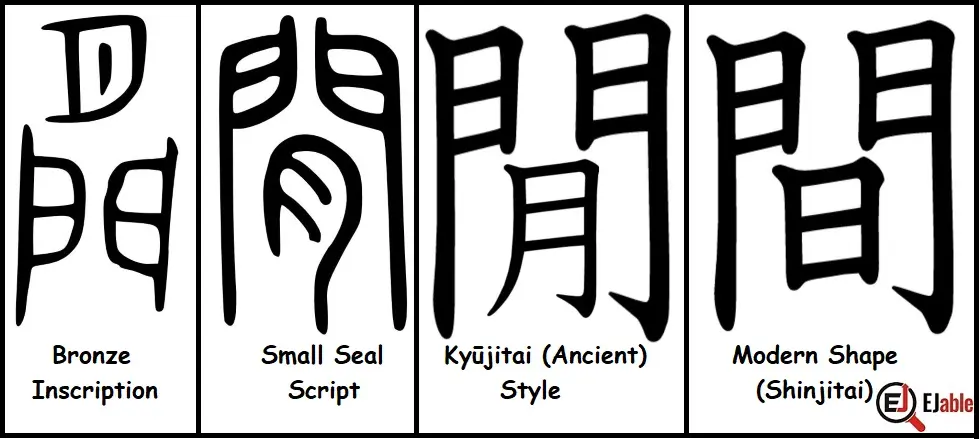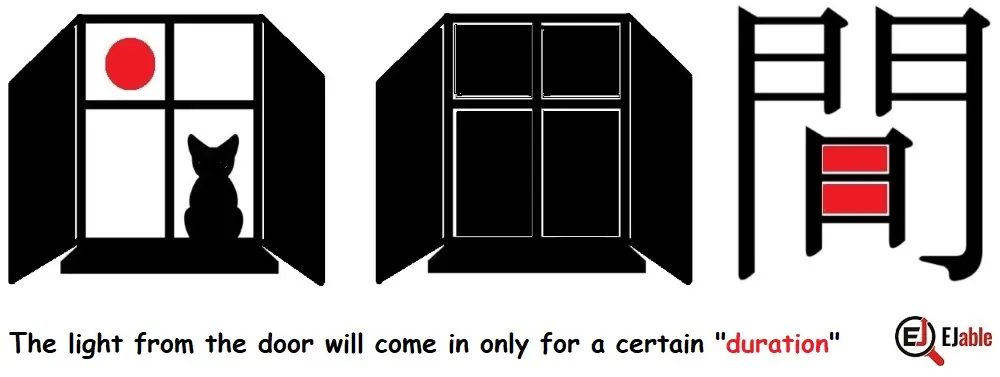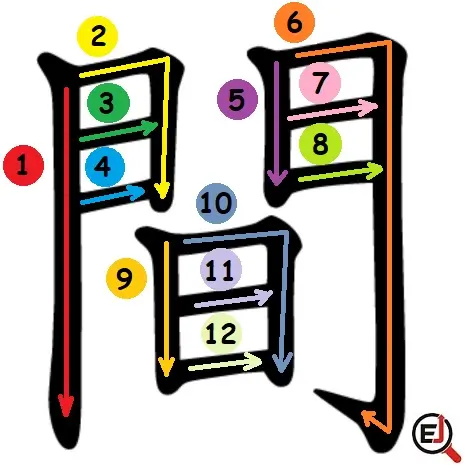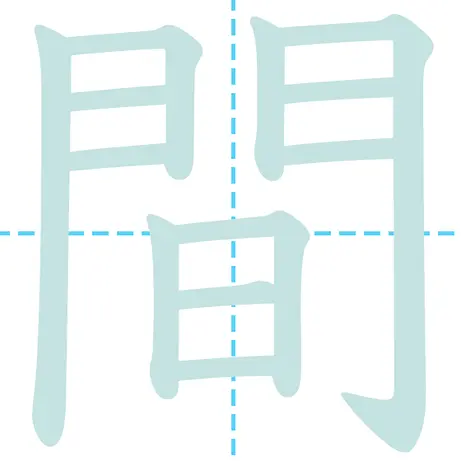Kanji for “Between”, “Interval”, “Duration”: 間 (aida / ma)

The kanji 間 means “Between (in-between),” “Interval,” or “duration.”
The kun’yomi (Japanese reading) pronunciation of the Kanji 間 is “ma” (ま) or “aida” (あいだ). The on’yomi (Chinese reading) pronunciation of 間 is “ken” (ケン) or “kan” (カン).
The meaning of the Kanji 間 extends from relating to time intervals to space or gap between physical objects or places.
間 quite commonly appears in Japanese names and is used in 2372 names. However, in names, it is pronounced as “chika” (ちか), “ha” (は), “haza” (はざ), or “hashi” (はし).
The Kanji 間 is constructed with 12 strokes. It is part of the JLPT N5 syllabus (please check the list of JLPT N5 Kanji). In Japanese schools, this Kanji is taught in grade 2.
Origin of the Shape 間
If we see the ancient shape (kyūjitai) of the Kanji 間, it shows the combination of a gate or door and a moon. with a cross-shape below it. This cross-shape can be interpreted as a blocker or weir to block and regulate the flow of water if we consider the gate as an entrance or barrier.
However, the modern shape of the Kanji 間 (shinjitai) is composed of two parts:
- The gate radical 門 (meaning “gate” or “door”)
- 日 (meaning “sun”)
We will delve into the possible logic later in this article, but firstly, let’s see the evolution of the shape of the Kanji 間 from ancient times to the current:

If we see the above illustration about the evolution of the Kanji 間, the Bronze inscription of it shows a moon above a gate. In the small seal script, the position of the moon changes, and it shows between the gate. The next evolved shape shows the evolved shapes of the Kanji for the gate and the Kanji of the moon.
However, the modern shape, or the shinjitai, had a big change when the moon was replaced by the kanji of the sun.
Mnemonic for the Kanji 間 Meaning “Between”, or “Duration”
Regardless of the ancient shape of the Kanji 間, with the moon within the gate or door or a sun instead of the moon, the logic behind the construction of this kanji remains the same.
Consider that you are in a room looking at the moon or sun from the opening of the door. You will only be able to see the moon or sun for a certain duration, or you will only be able to get the moonlight or sunlight for a certain period. That’s what the Kanji 間 means. From this time to this time, or an interval, or “between”. These meanings are not limited only to time but extend to physical space between objects of gaps.
The following illustration can serve as a mnemonic to remember the Kanji 間 for its meaning related to intervals or spaces:

Stroke Order for the Kanji 間
The following illustrations show the order of the 12 strokes to write the Kanji 間:


Other Meanings of 間
Beyond its primary meanings related to physical space and intervals, 間 carries several additional connotations:
- Room or Space: Refers to a physical area or room within a structure, highlighting the useable or livable part of a space.
- Interval or Period: Denotes a span of time or distance, emphasizing the duration or length between two points.
- Between or Among: Used to express relationships or positions relative to multiple objects or concepts, indicating a position or state that is not at the extremes but rather in the middle or among others.
- Cultural and Social Contexts: In Japanese, 間 plays a significant role in expressing concepts related to social and interpersonal space. For example, the word “aidagara” (間柄) with 間 means relationship.
- Architectural and Design Terms: 間 is used in architectural and design contexts to refer to dimensions, proportions, and the functional use of space.
Kanji 間 as a Radical or Component
The Kanji 間 is used as a radical or component in 5 Kanji characters. However, only one of those (簡) is Jōyō (commonly used) Kanji.
Examples of Kanji 間 as Radical or Component
- 簡 (かん / kan): Simple, simplicity; this Jōyō Kanji incorporates 間 in its composition, conveying the idea of simplification or brevity, possibly through the elimination of unnecessary “spaces” or components.
- 澗 (Non-Jōyō): Mountain stream; this character combines water (氵, the water radical) with 間, suggesting the flow of water through a gap, possibly a narrow or defined path in a mountainous area.
- 墹 (Non-Jōyō): This character is not commonly used in modern Japanese and lacks a widely recognized reading or specific meaning in contemporary contexts.
- 橺 (Non-Jōyō): Like 墹, this character is not part of the standard Jōyō Kanji set and is not commonly used or recognized in everyday Japanese language.
- 㗴 (Non-Jōyō): This character is also not part of the Jōyō Kanji or commonly used in modern Japanese, and it does not have a standard reading or meaning in contemporary usage.
間 Kanji in Compounded Words
There are 184 Japanese words that begin with the Kanji for “interval,” “between,” or “duration” (間), and overall it appears in 1114 words.
Examples of Kanji 間 in Compounded Kanji Characters
- 時間 (じかん / jikan): Time; the measure of hours or moments.
- 間隔 (かんかく / kankaku): Interval; the distance or period between two points or events.
- 空間 (くうかん / kūkan): Space; referring to physical or metaphorical space.
- 期間 (きかん / kikan): Period; a length of time with a specific start and end.
- 中間 (ちゅうかん / chūkan): Middle; the part or position equidistant between two points.
- 隙間 (すきま / sukima): Gap; a small space or interval between objects.
- 合間 (あいま / aima): Break; a short period of time between tasks or activities.
- 間柄 (あいだがら / aidagara): Relationship; the relation or connection between individuals.
- 瞬間 (しゅんかん / shunkan): Instant; a very brief moment in time.
- 時間割 (じかんわり / jikanwari): Timetable; a schedule that outlines time allocations.
- 間取り (まどり / madori): Floor plan; the layout of rooms within a building.
- 隔間 (かくかん / kakukan): Compartment; a sectioned-off part of a larger space.
- 建間 (たてま / tatema): Building interval; architectural term referring to the spacing of structural elements.
- 画間 (がま / gama): Picture interval; space designated for hanging pictures or scrolls, used in traditional Japanese architecture.
These examples more accurately reflect the usage of 間 in expressing concepts related to spatial and temporal intervals, relationships, and structural layouts.
Note: Check other Kanji characters on the page “How to Remember Kanji“. You may also like to read about common Kanji radicals.

A long-term ex-pat in Japan, Himanshu comes with an IT background in SAP consulting, IT Business Development, and then running the country operations of an IT consulting multinational. Himanshu is the co-founder and Managing Director of ReachExt K.K. and EJable.com. He is also an Advisory Board Member of a Silicon Valley AI/IoT startup.
